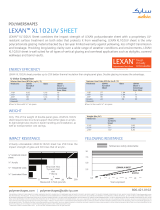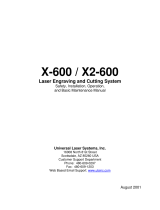
Acrylic Mirror Care Manual

Acrylic Mirror Care Manual
Product advantages of FABBACK Mirrored Acrylic:
REFLECTIVITY:
Approximately 85-90% over the 400-700 nanometer visual light
spectrum.
LIGHTWEIGHT:
Less than one half the weight of glass mirror of the same dimension and
thickness
BREAK RESISTANCE:
Superior break and impact resistance when compared to traditional glass
mirror. Up to 10 times more break resistant and 17 times greater impact
resistance than traditional glass mirror of the same dimension and
thickness
HEAT:
Can tolerate continuous heat exposure up to 160 degrees F. Can
withstand occasional short-term exposure up to 190 degrees F.
EASILY FABRICATED:
Can be easily cut, routed, & drilled to create custom sizes and shapes for
any project. Using the correct blades, cutters, & bits, FABBACK acrylic
mirror can be easily fabricated using many common tools.
FABBACK Mirrored Acrylic is a strong, lightweight thermoplastic
sheet that is designed to be used as a replacement for
traditional glass mirror. Its greater impact and break strength
makes this an ideal product to be used in situations where
there is a higher level of concern for safety. With over 19
different colors available, multiple thicknesses and coatings,
FABBACK acrylic mirror has the sheet you need for just about
any project.

Acrylic Mirror Care Manual
Handling:
All FABBACK
®
acrylic mirror sheets are furnished with protective masking
on the reflective side of the sheet. Do not slide mirror when transporting
and always store acrylic mirror in a clean, dry location with masking left
in place until the sheet is ready to use.
Vertical Storage:
If mirror sheets are to be stored or transported on end
(vertically), care must be taken to avoid warping. Sheets must
stand with an angle no more than 10 degrees from vertical. Care
should be taken to make sure the sheets are properly supported.
Always store sheets with factory applied masking until ready for
use.
Horizontal Storage:
If mirror sheets are to be stored or transported flat (horizontally),
care should be taken to avoid warping, sliding and scratching. If
different sizes are being stored together, make sure that largest
sizes are at the bottom with smaller sizes stacked on top. Be sure
to keep debris from settling between sheets, this may cause
scratching. Always store material with factory applied masking until
ready for use.
Maintenance:
Each sheet is well protected by a durable paint backing and removable
masking on the reflective side. Masking should remain in place to protect
sheets during the fabrication or installation process. If there is difficulty
removing the masking, use aliphatic naptha, kerosene, or distilled
alcohol. Do not use other chemicals or sharp objects to remove masking.

Acrylic Mirror Care Manual
Cleaning:
WASHING:
When washing FABBACK acrylic mirror sheets use mild soap and a
damp cloth to wipe the surface using light pressure. For harder to
remove items use hexane or kerosene to remove. Avoid window
cleaning sprays, kitchen scouring compounds or other chemicals
to clean mirror sheets.
POLISHING:
Surface gloss can be maintained by occasionally using a soft cloth
and good plastic cleaner or polish. Follow instructions on the
container when polishing.
REMOVING SCRATCHES:
Fine scratches maybe removed by hand polishing with a plastic
polish/scratch remover/cleaner. Remove all residue and polish
with a soft cloth.
Drilling:
FABBACK acrylic mirror can be easily drilled with any commercial power-
driven portable drill, drill press, lathe, or automatic multiple-spindle drilling
unit.
It is recommended that you use a bit designed specifically for use with
plastics. If a plastic drill bit is not available please adhere to the following
criteria:
1. Drill tip must have a sharp angle of 60-90 degrees to allow bit to enter
and exit sheet easily without chipping.
2. Bit cutting edge must have a rake angle of 0-4 degrees. The flat
cutting edge is designed to scrape material rather than gouge it.
3. Bit surface behind the cutting edge is recommended to have clearance
angles of 12-15 degrees to allow back relief for reduced metal to plastic
contact and heat build up.
When drilling acrylic mirror back the sheet with a durable surface such as
plywood. This will allow the bit to continue into the solid material and will
decrease the risk of chipping. A slow feed rate should be used when
penetrating and exiting the sheet.

Acrylic Mirror Care Manual
*It is recommended that a cool air mist be in contact with the blades of all cutting devices before and during
penetration of plastic.*
Cutting:
CIRCULAR/TABLE SAW:
Method designed to achieve quick, straight line cut of multiple sheets of
acrylic mirror. A 10” 80 tooth carbide tipped blade is recommended for
cutting FABBACK acrylic sheets. Teeth should be triple-chip design,
where every other tooth has a beveled cutting edge to help clear away
saw chips. Make sure to cut using a smooth even feed rate and always
leave protective masking in place while cutting. Uneven feed rates and
removing masking before cutting may cause gumming/chipping of sheet
and scratching of surface.
SABER SAW:
Generally used in applications that require multiple changes in direction
while cutting. Use clamps to hold sheets in place to reduce vibrations
that may lead to chipping while cutting. Set speed to “full” and keep
feed speed even when cutting acrylic mirror sheets. Use a blade with at
least 14 teeth per inch.
JIG SAW:
Used primarily for inside and intricate cuts. Since the stroke is short, the
blade can heat up quickly causing the sheet to soften and the blade to
adhere to the sheet. To avoid this a use fast even feed rate. Use blades
with at least 14 teeth per inch.
BAND SAW:
Used for cutting curved edges and trimming of sheets. Blades for band
saws should have at least 10 teeth per inch.
SCRIBING & BREAKING:
Method designed to achieve a quick, straight line cut on a single sheet of
mirror acrylic. Recommended for sheets with a thickness of 3mm or less.
Mark line on sheet to be scored. Using a plastic cutting tool, score the
line drawn on sheet multiple times using a straight edge as a guide.
Overhang the end of the sheet over the edge of a table and snap the
score line with sharp downward pressure.

Acrylic Mirror Care Manual
© 2010. All rights reserved.
All trademarks are subject to the ownership rights of their respective owners.
Information contained herein has been provided with permission by Plaskolite, Inc.
THE MATERIALS, PRODUCTS AND SERVICES OF SABIC POLYMERSHAPES (“SELLER”), ARE SOLD SUBJECT TO SELLER’S STANDARD CONDITIONS
OF SALE, WHICH CAN BE FOUND AT http://www.sabicpolymershapes.com
AND ARE AVAILABLE UPON REQUEST. ALTHOUGH ANY INFORMATION
CONTAINED HEREIN IS GIVEN IN GOOD FAITH, SELLER MAKES NO WARRANTY OR GUARANTEE, EXPRESS OR IMPLIED, (i) THAT THE RESULTS
DESCRIBED HEREIN WILL BE OBTAINED UNDER END-USE CONDITIONS, OR (ii) AS TO THE EFFECTIVENESS OR SAFETY OF ANY DESIGN
INCORPORATING SELLER’S PRODUCTS, SERVICES OR RECOMMENDATIONS. EXCEPT AS PROVIDED IN SELLER’S STANDARD CONDITIONS OF
SALE, SELLER SHALL NOT BE RESPONSIBLE FOR ANY LOSS RESULTING FROM ANY USE OF ITS PRODUCTS OR SERVICES DESCRIBED
HEREIN. Each user is responsible for making its own determination as to the suitability of Seller’s products, services or recommendations for the
user’s particular use through appropriate end-use testing and analysis. Nothing in any document or oral statement shall be deemed to alter or
waive any provision of Seller’s Standard Conditions of Sale or this Disclaimer, unless it is specifically agreed to in writing signed by Seller. No
statement by Seller concerning a possible use of any product, service or design is intended, or should be construed, to grant any license under any
patent or other intellectual property right of Seller or as a recommendation for the use of such product, service or design in a manner that infringes
any patent or other intellectual property right.
General info:
CHEMICAL RESISTANCE:
Like all plastic materials, FABBACK acrylic mirror will react when exposed
to many chemicals. Below is a partial list of chemicals known to react with
these sheets.
BENZENE ETHYL ALCOHOL
LACQUER THINNERS KETONES
TOLUENE METHYL ALCOHOL
CARBON TETRACHLORIDE ETHERS
ESTERS
WEATHER/MOISTURE RESISTANCE:
Acrylic mirror products are not recommended for outdoor use and window
glazing applications. If used outdoors, seal perimeter with silicone sealant
to protect against moisture and protect mirror backing. It is also
recommended that acrylic mirror is not used in applications such as shower
doors and in areas of extreme humidity. These applications can cause the
mirror to expand and contract and can possibly damage the sheet.
FLAMMABILITY:
Precautions normally used to protect wood and other combustibles from
flame and high heat should be observed with acrylic mirror.
For further information and assistance
contact your SABIC Polymershapes customer care team at
800
800
-
-
421
421
-
-
0102
0102 or
sabicip.nationalaccounts@sabic
sabicip.nationalaccounts@sabic
-
-
ip.com
ip.com.
-
 1
1
-
 2
2
-
 3
3
-
 4
4
-
 5
5
-
 6
6
Ask a question and I''ll find the answer in the document
Finding information in a document is now easier with AI
Related papers
Other documents
-
Craftsman TS3650 User manual
-
 LEXAN GE-38 Specification
LEXAN GE-38 Specification
-
Infocus M-300 User manual
-
Proxxon 37090 User manual
-
 Universal Laser Systems X2-600 User manual
Universal Laser Systems X2-600 User manual
-
James Hardie 617601 Installation guide
-
James Hardie 974131 Installation guide
-
James Hardie 215518 Installation guide
-
Builders Choice HDX164341 Installation guide
-
HardiePlank 6851131 Installation guide







